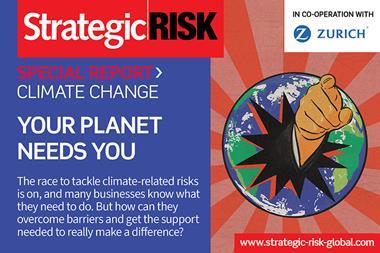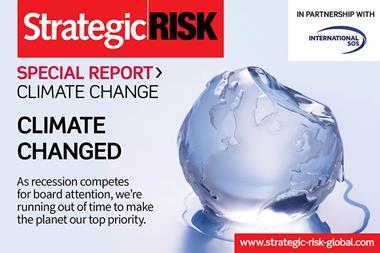How do risk managers prepare an adaptation plan in the face of increasing weather extremes?
On 15 December, StrategicRISK hosted a webinar to discuss physical climate change risk, how its impacts can be better understood now and into the future, and how risk professionals should go about preparing an adaptation plan.
Taking part in the discussion, in partnership with Swiss Re Corporate Solutions, were Sarah Gordon, chief executive of Satarla, Adrian Clements, president of AT-IPIC and Annemarie Büttner, Lead Climate Risk Solutions at Swiss Re Corporate Solutions.
The conversation began with a look back at some of the extreme weather the world had experienced in 2022, with Gordon noting the fact that it was currently snowing in both the UK and Australia as fairly unusual.
“We are seeing shifting weather patterns coming to the fore,” she said, “and there are many examples over the past year. And then there are all the non-physical risks - transition, regulations, societal expectations - all of that is growing teeth and becoming real.”
The IPCC warns we should expect increasing physical risks now and into the future, which will vary depending on differing scenarios.
The panellists acknowledged that organisations were already feeling the disruption from these events - either directly or indirectly within their wider value chain.
“It is very difficult to pin climate change to single events, because it is a long-term trend, but you can see it - for example when you look at the amount of electricity or airconditioning you have been using over several years,” said Büttner.
Impacts on business
With anticipation that climate will become more extreme and unpredictable over time, it is clear that corporate risk managers need to be preparing for this.
“In order to be resilient and cope with these changes we’re seeing companies having to rethink their storage, for instance,” said Clements. “They need more stock to cope with it, and alternative suppliers, which don’t have the same footprints. Companies are having to relocate assets which are no longer tenable in certain locations.”
The impact of physical climate change on the business inevitably varies from one industry sector to the next, but there is no escaping it. Gordon pointed out that it is not just about extreme weather events or temperatures, but resource scarcity and the impact on society as well.
”Where you’ve got average temperatures going up in various parts of the world that makes it very difficult, as a human being, just to turn up for work. When we talk about climate change, we’re not just talking about emissions.”
“For some industries the direct impact of that changing climate are very apparent,” she continued. ”However for other industries that’s out there at some point in your supply chain - somebody is going to be directly impacted and it’s probably not very far away.”
Büttner offered the example of a client in the food and beverages sector which kanufactures dairy products. “Their main source of vanilla is from Madagascar, and it’s already being impacted by climate change in terms of water scarcity,” she explained.
“The population on the island is facing massive growth and more than half of the residents do not have access to clean drinking water. Vanilla production requires water for production too - so it’s not just an environmental issue but also social problem.”
The role of the risk manager
So how do we measure the impact of these on our business and wider value chain in order to take steps to mitigate some of the more extreme risks presented by a changing climate?
“Companies need to identify the high-risk countries and sectors and assess current risk versus future risk as they design climate adaptation plan to mitigate risk and make informed decisions,” explained Büttner.
For risk managers practising enterprise risk management (ERM), sustainability is already a big and growing part of their remit - or at least it should be, thought Gordon.
“We are dealing with something that’s so different to what we saw in the past, and that’s where risk managers are so important because we don’t know what the future holds, but we’re experts at putting in place some quite good guesses and saying, ’Based on these different scenarios, how do we reduce the potential for threats or seize new opportunities.”
“It’s not just about trying to hit Net Zero, but about using it to inform a ’just’ transition - so we don’t increase the rich/poor divide.
“Risk managers provide the organised mechanism through which we can achieve positive impact with regards to climate change.
“It’s nothing new for risk management. Do we need to step up? Absolutely.”
The inability to look at historical events to predict what might happen in the future also means we need the courage to fundamentally rethink our approach to business and risk management, according to Clements.
“Risk managers have the issue of aggregation to deal with. There are going to be more of these [shock events] and they’re going to be bigger so you need to look into the future and ask, ’what did my company promise?’ he explained.
“Each company has made a promise to its customers and suppliers, which is your purpose. So what is it and are you delivering on it? This is changing the scope, role and responsibility of the risk manager.
“Business models have to be reviewed. You can no longer fine-tune old business models if you’re going to have ten hurricanes or massive flooding in ten of your locations each year.”
Like Gordon, he emphasised the importance of thinking about the people risk aspects. You can make your factories as resilient as possible, but if people are unable to get to work, it is a wasted investment.
No time to waste
The panellists urged action, even as we grapple with uncertainty and lack of data in some instances. Whereas natural catastrophe modelling once relied heavily on historical loss trends, there has been a significant change in mindset.
“We are really changing the game here and we cannot rely on the past anymore,” noted Büttner. ”We have to work with real data and future climate models and really model for the coming years differently, which will help with organisations’ sustainability trajectories as they look to build resilience moving forward.
“Of course the first priority for all of us is to reduce our emissions, and we’re not yet there yet but there’s still time to adapt and change the game.”
It is impossible to predict every future climate change scenario, but it should not impede how companies take action - with risk managers enabling bold decisions to be made.
“This isn’t about determining when something will happen in the future,” said Gordon. “It’s about working backwards and saying, ’If that’s what the future might hold, when do we need to start doing something about it?
“Because if we wait to see if the science is correct, we’re totally scuppered. This is not something where we can wait and get lots of lovely datasets - it’s about taking a deep breath and taking a whole load of actions - knowing that some of them won’t work.”
“We are past the tipping point of when we needed to take action - it’s about making changes and doing it really quite quickly.”




















No comments yet